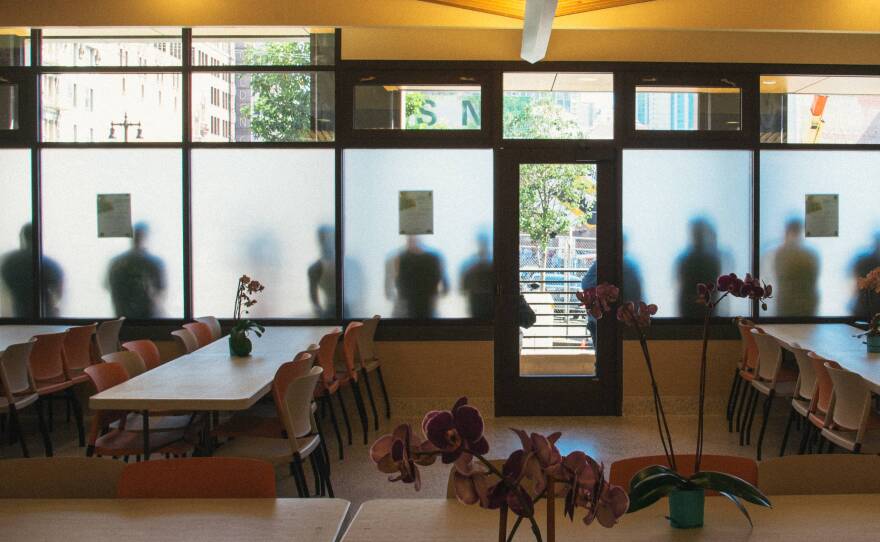It’s no wonder that the Tenderloin has become a melting pot of San Francisco’s vibrant Asian and Latino immigrant culture.
The neighborhood is often the first stop for many immigrants to the city. Nearly 30 languages are spoken within a 10-block radius. It’s only getting more diverse, and service workers, nonprofits, and soup kitchens are struggling to keep up.
If you want to see that process at play, look no further than the dining room at St. Anthony’s Foundation, which, among other services, provides about 40% of San Francisco’s free meals every day.
When the breakfast service starts in the refurbished dining room, which opened in November, most of the volunteers stand behind the counter, piling plates with corn and fresh fruit, stirring soup, and washing dishes.
Michael Chan is not one of them. Four days a week, he commutes from the Sunset district to volunteer at St. Anthony’s. Chan, first drawn here by his Catholic faith, serves more than food. He’s a middleman between the English-speaking staff and the Cantonese-speaking diners here.
The foundation has come to rely on him. He’s the only Chinese-speaking volunteer in the diverse dining room. When I came down to St. Anthony’s to meet him, he was already tending to several tables packed with Chinese women and their families, many wearing fleeces over their traditional Mandarin jackets.
“It gets pretty busy around 10 o’clock,” Chan tells me.
The diners reflect the changing demographics of the neighborhood. Census projections show the Tenderloin getting older and more diverse over the next decade. More than half of residents do not speak English at home – and many come from countries like China, Russia, El Salvador, and the Philippines.
But outside of a brown bag and social work, St. Anthony’s doesn’t offer many formal programs for patrons that don’t speak English. That doesn’t mean they don’t want to. Cindy Escobar says volunteers have really taken the initiative as translators.
“I think it came about when volunteers we’ll see sometimes will struggle communicating with guests, and then they’ll kind of volunteer on their own, like, ‘Oh, I can translate,’” Escobar reflects. “So that’s how it started off. It happened in the dining room, in the lines.”
Chan springs to action to help out as the patrons dig in. Volunteer Coordinator Giovanna Erkanat wants his help getting Chinese women to fill in the empty seats in the family section.
“It’s not just for families, it’s for women,” Erkanat tells Chan. “Tell them, like you did yesterday.”
“I talked to them yesterday,” Chan replies. “They told me they don’t want to sit there because they want to get served first.”
New kitchen, new rules
As it turns out, these women will get served first, if they sit in the new section. Getting them there is not as easy as it sounds. These women are just settled in the new dining room. Now, Chan has to tell them to switch spots.
“I hope they will come here,” Chan says skeptically.
While Chan is working at the grassroots level the dining room, Father Jose Luis Aguirre is trying to implement language services on a broader scale. He’s been working at St. Anthony’s for more than four years now, and says they’ve developed prayer services in Spanish, Vietnamese, and Tagalog to help patrons feel comfortable. But Aguirre says the foundation should be more aggressive in dealing with the issue to support clients.
“We have to introduce a different premise, so you can not just serve the meal, but communicate with the guests in the dining room. I have expressed it myself because I speak Spanish and English,” Aguirre notes. “They feel good when you sit at the table and talk to them, not just bring the tray.”
Aguirre whisks me out of the dining room to show me what he means by that. He takes me across the street to St. Anthony’s Medical Clinic. Aguirre often stops by to talk to Spanish speakers about the services here.
Sonia Navarro came in today for a simple check-up. She has been coming in two years, and says everyone has always been very helpful, but she also tells Aguirre that the foundation could do a better job of getting the word out about its services. She says many Spanish speakers in the Tenderloin don’t even know about the clinic.
With Navarro’s idea in mind, Aguirre says St. Anthony’s can work to provide more information in foreign languages: “Whatever is being published in English, it would be beneficial for people and also to get involved in the programs if they have the information in Spanish or Vietnamese.”
As we’re talking, my gaze shifts back over to Chan, who is still struggling to get people into the women and children’s section.
It looks like a lost cause, until eventually, an older woman and child come in and start eating.
The Foundation is hoping to attract more Chinese and Spanish speaking volunteers to the dining room. For now, they’re figuring out how to recruit that help.
Find out how to volunteer your language skills at St. Anthony's Foundation here.








